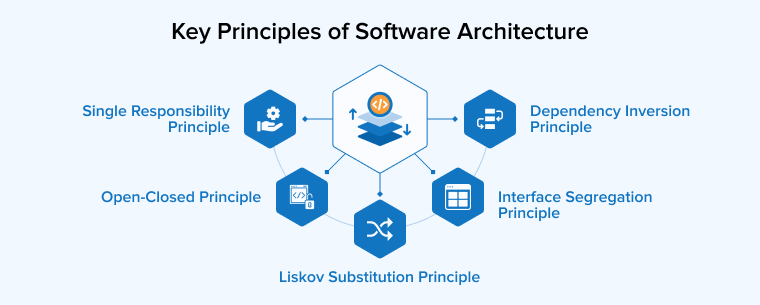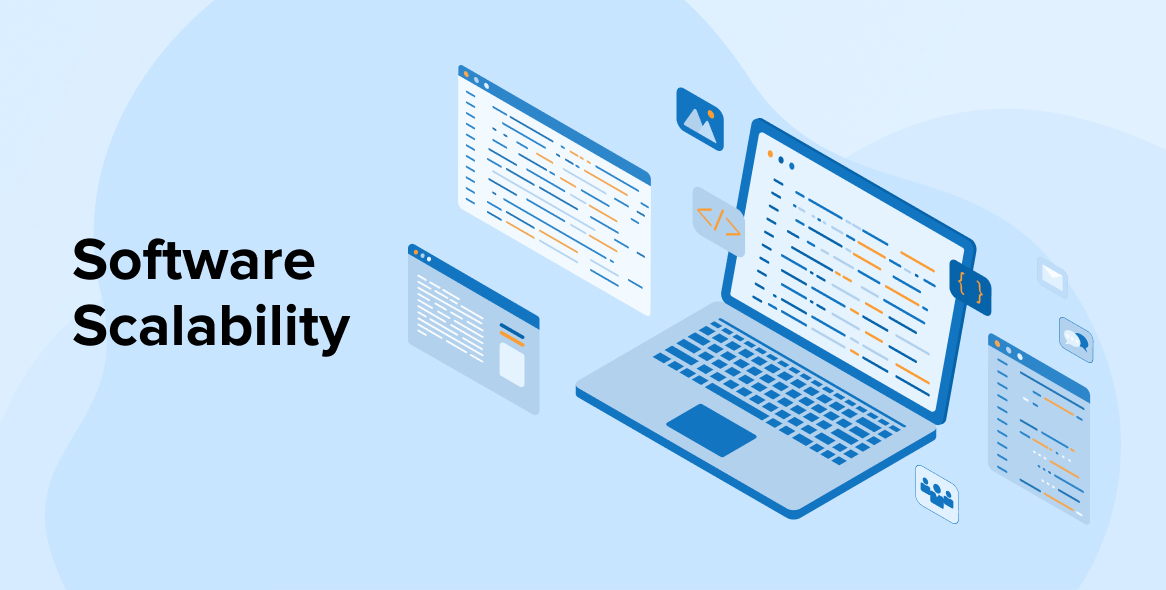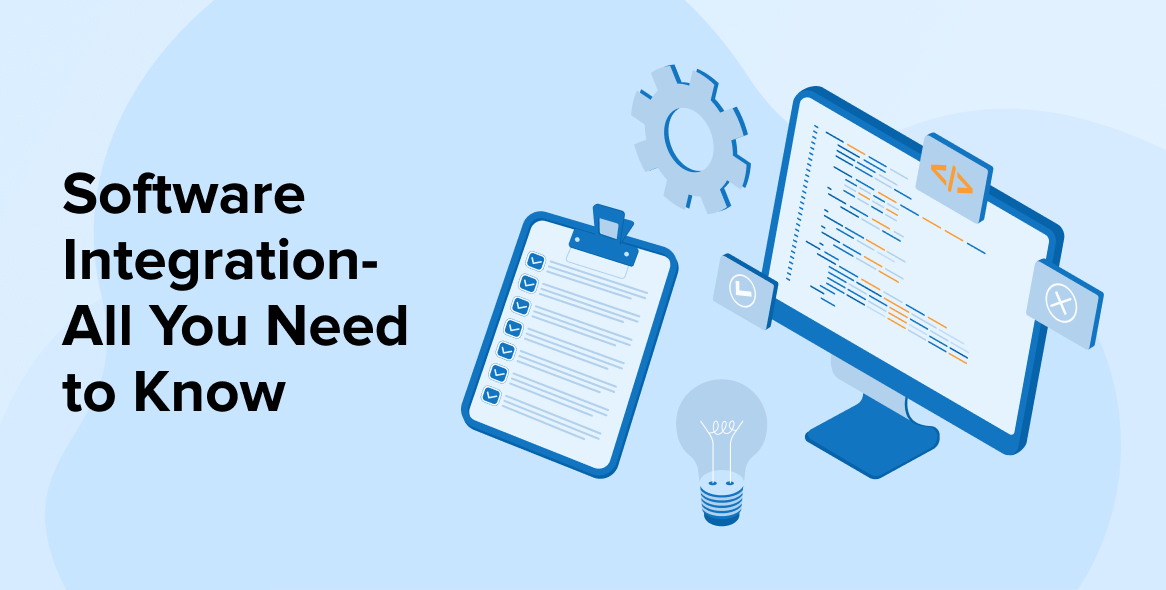
Errors, bugs, or flaws- these are just different names for one common problem of an application. One of the biggest reasons why an application fails is because of the flaw in the architecture of the application. But if you have prior knowledge you’d understand how architecture plays a pivotal role in the development of the app.
The blueprint for a software system is called Software architecture. It establishes a communication and coordination mechanism among components by providing an abstraction to manage system complexity. It specifies a structured solution that satisfies all technical, operational, and functional requirements while enhancing common quality attributes such as performance and security.
Furthermore, it entails a series of important organizational decisions pertaining to software development, each of which can have a significant impact on the final product’s quality, maintainability, performance, and overall success.
In this blog, we will understand how software architecture is built, what are the principles that a software development service firm should keep in mind while developing such architecture, and also the most commonly used architectural patterns. For that, we must start off with an understanding of Software Architecture and how businesses that leverage software architecture services progress.
1. What is Software Architecture?
Software architecture is a way the system works to make processes simpler, efficient, and organized. Software Architecture setup includes all components, how they interact with one another, their operating environment, and the software design principles. In the field of Software Architecture design, it can also include how the software’s evolution in the future would take place for many software applications.
The architecture of the software is created with a specific mission, long-term business objective, and keeping architecture analysis in mind. Thus, when a software application is created, they have a specific mission that is carried out without hindering other tools or devices. The behavior and structure of software have a significant impact on decisions, so they must be rendered and built properly for the best business results.
1.1 Why Does Software Architecture Matter?
It specifies a structured solution that satisfies all technical and operational requirements while enhancing common quality attributes such as performance and security. The foundation of any software system is its architecture. The foundation, like in other types of engineering, has a significant impact on the quality of the structures that are built on top of it. As a result, it’s critical to the software systems development and eventual upkeep.
A sequence of decisions makes up software architecture. Designing the architecture leads to some of the first decisions, which have a significant impact on subsequent decisions. To succeed, you’ll need a well-thought-out architecture as a software system grows in size and complexity. When done correctly, software architectural design has a variety of advantages that considerably boost the likelihood of success.
Furthermore, it entails a series of important organizational decisions pertaining to software development, each of which can have a significant impact on the final product and its quality, maintainability, performance, conceptual integrity, and overall success. These choices are made up of the following:
- The system architecture you put together helps you to select the essential structural elements and their interfaces.
- In collaborations between those elements, behavior is specified.
- These structural and behavioral elements are grouped together to form a large subsystem.
- Business goals are aligned with architectural decisions.
- The organization is led by architectural styles.
Now, after understanding the need for software architecture, it is time what makes software architecture stronger and compatible with other software development projects. Here are some of the key principles:
2. Key Principles of Software Architecture

Below are the key principles of software architecture to follow.
2.1 Single Responsibility Principle
When you start to develop an application you would need to keep the SRP in mind in order to develop an app. This SRP will be followed in every class, module, function, and even program. Using SRP indicates that every class, module, or program should have just one reason to change.
2.2 Open-Closed Principle
In this principle software entities which include classes, modules, functions, and so on will have a space for extension but it will be closed for modification. According to the Open-Closed Principle, it is open but closed for any type of alterations. This also means that the entities can have extended behavior without having to change the source code.
2.3 Liskov Substitution Principle
In this principle, the functions that you use as objects are derived from specific classes and will use pointers and references to base classes without having to declare them explicitly. This means you have pointers as substitutes to the base classes and that is the reason behind this name.
2.4 Interface Segregation Principle
Clients should not be compelled to rely on interfaces that they do not use, according to the Interface Segregation Principle. Client-specific interfaces are frequently superior to interfaces that are designed for universal use.
2.5 Dependency Inversion Principle
According to the Dependency Inversion Principle, high-level modules should not rely on low-level modules. Abstractions should be used in both cases. In truth, abstractions should not be dependent on specifics, but rather on details. The idea behind the principle is that it is preferable to rely on abstractions rather than concrete data.
Now that you are quite clear with the understanding of Software Architecture and its principles, it’s time for you to know which characteristics make it ideal for businesses.
3. Software Architecture Characteristics
Architecture characteristics are critically an essential factor to the success of any software architecture. One can debate various System Quality Attributes, but the following architectural characteristics provide a strong foundation for modern software architecture to design a successful product.
- Performance: If your software architecture is up to the mark then, you can expect all your actions are performed within the respected period of time.
- Reliability & Availability: A check on this attribute ensures that you have built a secure and safe environment for your users to work on the system-developed architecture.
- Security: You can add this into your system to smoothly ensure that there are no security breaches or attempts of hacking or leaking information through websites.
- Maintainability: An ability to adapt and embrace changes and updates will keep the app at the top of the game.
- Modularity: When it comes to the modularity of applications, there are some common changes that determine changes made within each class or module.
- Scalability: Scalability will provide the system with the ability to withstand increasing loads without compromising on performance, or the ability to rapidly raise the load.
4. Common Software Architecture Patterns
Here are different patterns used in software architecture.
4.1 Layered Architecture Pattern
If we were to describe “layered architecture pattern,” then the most commonly used term is “multi-tiered architecture.” It’s one of the most used patterns to arrange code and that is done in layers.
In this type, the data enters the system from its outermost layer. Hence in this, the data flows through the following layers until it reaches the database layer, which is the innermost layer.
When you use this pattern, it has at least three layers, including a display/presentation layer, an application layer, and a data layer in simple implementations. Users interact with the presentation layer via a graphical user interface, while the application layer handles business logic. The data layer has a database for data storage and retrieval.
4.2 Event-Driven Pattern
In this furious shift of creating apps, the software components are detached and configured to identify, process, and respond to the ‘events’. Suppose you made a mouse click or typed a key on your keyboard, asynchronously, these are events for a system. Similarly, if you do an online purchase, the ‘event developer’ is a component that would detect the initial event like a customer placing the order. Similarly, if you perform any other actions like calculating VAT or notifying the client, or having clicked any other special functionality, then it will respond in the way you perform the event.
You will also find a central unit that will typically serve as a “mediator” or a “middle man” which serves the purpose of accepting information from event producers and assigning it to the appropriate event consumers. Due to its flexibility and scalability, it is often used in apps.
4.3 Microkernel Architecture Pattern
When you decide to use the Microkernel Architecture pattern, you’ll see that there are two types of components that form this software architecture pattern. The first one is a core system and the second one is a number of plug-in modules. While the core system just performs the bare minimum to keep the system running, the plug-in modules are separate components that perform specialized processing.
From the standpoint of a business application, the core system can be characterized as generic business logic that does not include specialized code for particular circumstances, special rules, or complex conditional processes. The plug-in modules, on the other hand, are designed to supplement the basic system and provide extra commercial capabilities.
4.4 Microservices Architecture Pattern
Monolithic applications and service-oriented architectures are viewed as viable alternatives to microservices design patterns. Through an efficient and optimized distribution pipeline, the components are deployed as individual modules. Increased scalability and a high degree of separation inside the application are two of the pattern’s advantages.
The components are accessed through a remote access protocol because of their disconnected and independent nature. In addition, the same components can be designed, deployed, and tested independently of one another.
4.5 Space-based Architecture Pattern
When you use a space-based architectural pattern, you are utilizing it in a space in a unique way. This approach means, there will be a distributed system that will interact with various components inside the computing system. These distributed systems will exchange information through tuples and entries from one shared space to another.
Most developers suggest this whenever they want to eliminate issues of scalability or concurrency. By distributing processing and storage over numerous servers, the space-based system’s architecture avoids functional collapse under excessive demand.
- This type of architecture responds fast even in a continuously changing environment.
- Although space-based designs are not often decoupled or distributed, they are dynamic, and powerful cloud-based technologies making it simple to “push” applications out to servers and ease deployment.
- The in-memory data access and caching algorithms included in this pattern help to achieve high performance with meticulous implementation details.
5. What Do Software Architects Do?
Software architects are someone who understands how each function works and how it affects the performance of the application, resilience, reuse, comprehensibility, scalability, security, technology limits, and similar other tradeoffs are all important considerations for all software architects. Also, in software engineering when it comes to decision making, a software architect makes certain judgments that are communicated properly to various stakeholders as well as software development personnel. Hence a software architect creates and designs a solution for the entire application and provides the software development team with necessary implementation details.
While software architects’ specific roles vary depending on project size and requirements, it’s crucial to understand how they differ from one key to other specialists working on the same software solution. All the software architects have the same aim and agenda in mind which is to create a successful product and also plan for software evolution.
6. Conclusion
Architectural patterns are the base and foundation of how you plan to build your software though it is still an emerging discipline with certain limitations. There is nothing like one size fits all because when it comes to the architecture of software, you have custom needs and as per those needs, the app can be built.






Comments
Leave a message...